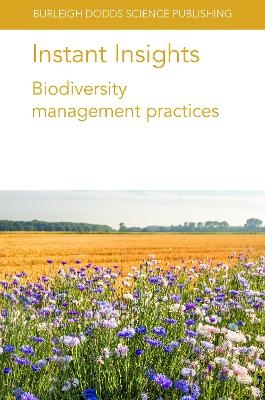
Instant Insights: Biodiversity Management Practices
Burleigh Dodds Science Publishing Limited (Verlag)
978-1-80146-402-4 (ISBN)
The first chapter reviews biodiversity management practices and benefits in Conservation Agriculture (CA) systems. After looking at the importance of soil microorganisms, the chapter looks at how CA systems contribute to soil biological activity, particularly the way cover crops and rotations, with a no-till regime, can enrich soil and the multitude or organisms living in it.
The second chapter synthesizes and reviews the published information on grass hedges and their soil benefits, to better understand the potential of grass hedges for managing water erosion as well as improving soil health in agricultural lands.
The third chapter reviews research on ways of modifying the agricultural landscape to reverse the decline in a range of fauna and flora. The chapter also reviews the characteristics and types of field margins, as well as their role in agroecosystems. The chapter concludes with a discussion on managing field margins to promote insect biodiversity and rare arable plant populations.
The final chapter considers the impact of agricultural intensification on agricultural landscapes, farming systems and biodiversity. The chapter highlights how hedgerows can contribute to the multifunctionality of agroecosystems in intensively-managed agricultural landscapes, focussing on improved pest regulation and enhanced pollination services.
Scott worked for Manitoba Agriculture as an agricultural extension specialist for over 23 years, before creating Fall-Line-Capital Inc - a company which invests in farmland and the latest agricultural technologies. Scott continues to enjoy international speaking opportunities, and contributing to Agronomy books and publications, most recently with the FAO/United Nations, the University of Adelaide, No-Till Farmer Magazine, and The Western Producer.
Chapter 1 - Biodiversity management practices and benefits in Conservation Agriculture systems: Scott Day, Treelane Farms Ltd, Canada; Ademir Calegari, Agricultural Research Institute of Paraná State (IAPAR), Brazil; Alessandra Santos, Marcus Cremonesi, Lilianne Maia and Wilian Demetrio, Federal University of Paraná, Brazil; and Marie L. C. Bartz, Coimbra University, Portugal; 1 Introduction2 Soil microorganisms and their importance3 Effects of cropping practices on soil biodiversity and ecosystem functioning4 Effectiveness of diversified CA cropping systems5 Case study: biodiversity management practices and benefits in CA systems in South-West Manitoba (Canada)6 Where to look for further information7 References
Chapter 2 Conservation grass hedges and soil health parameters: Humberto Blanco-Canqui, University of Nebraska, USA; 1 Introduction2 Erosion3 Soil properties4 Food, feed and fuel production5 Biodiversity or wildlife habitat6 Factors affecting the performance of grass hedges7 Summary8 Future trends9 Where to look for further information10 References
Chapter 3 The role of field margins in biodiversity conservation in agroecosystems: Alicia Cirujeda and Gabriel Pardo, Centro de Investigación y Tecnología Agroalimentaria de Aragón (CITA-Universidad de Zaragoza), Spain; 1 Introduction2 Options for promoting biodiversity in agricultural landscapes3 Field margins: characteristics and types4 The role of field margins in agroecosystems5 Managing field margins to promote insect biodiversity6 Managing field margins to promote rare arable plants, reptiles, amphibians, birds and mammals7 Conclusions8 Where to look for further information9 References
Chapter 4 The role of hedgerows in supporting biodiversity and other ecosystem services in intensively managed agricultural landscapes: Audrey Alignier, Léa Uroy and Stéphanie Aviron, INRAE, France; 1 Introduction2 What is a hedgerow?3 The role of hedgerows as habitat for biodiversity4 Hedgerows and hedgerow networks5 Hedgerows and ecosystem services6 Case study: hedgerow plantation and bocage restoration enhance biodiversity and other ecosystem services7 Summary and future trends8 Where to look for further information9 References
| Erscheinungsdatum | 19.04.2022 |
|---|---|
| Reihe/Serie | Burleigh Dodds Science: Instant Insights ; 53 |
| Zusatzinfo | Color tables, photos and figures |
| Verlagsort | Cambridge |
| Sprache | englisch |
| Maße | 152 x 229 mm |
| Gewicht | 180 g |
| Themenwelt | Naturwissenschaften ► Geowissenschaften ► Geografie / Kartografie |
| Naturwissenschaften ► Geowissenschaften ► Geologie | |
| Weitere Fachgebiete ► Land- / Forstwirtschaft / Fischerei | |
| ISBN-10 | 1-80146-402-2 / 1801464022 |
| ISBN-13 | 978-1-80146-402-4 / 9781801464024 |
| Zustand | Neuware |
| Haben Sie eine Frage zum Produkt? |
aus dem Bereich


